Analysis of EMS Privatization in Saudi Arabia: A Business Perspective
VerifiedAdded on 2022/09/08
|10
|2446
|21
Report
AI Summary
This report provides a comprehensive analysis of the privatization of Emergency Medical Services (EMS) in Saudi Arabia, examining the current state of EMS, challenges in service delivery, and the potential benefits of privatization from a business administration perspective. The study explores the role of the Saudi Red Crescent Authority (SRCA), gaps in EMS delivery, and the rationale for privatization, considering factors such as healthcare costs, resource allocation, and the need for improved efficiency. The report delves into relevant theories like agency theory, public choice theory, and property rights theory to support the privatization argument. It also examines the strategies for privatization, including policy and regulatory considerations, and proposes a qualitative case study methodology involving expert interviews and thematic analysis to explore the topic in-depth. The report highlights the challenges of the current system and proposes privatization as a solution to address these challenges. The document is contributed by a student to be published on the website Desklib, a platform which provides all the necessary AI based study tools for students.
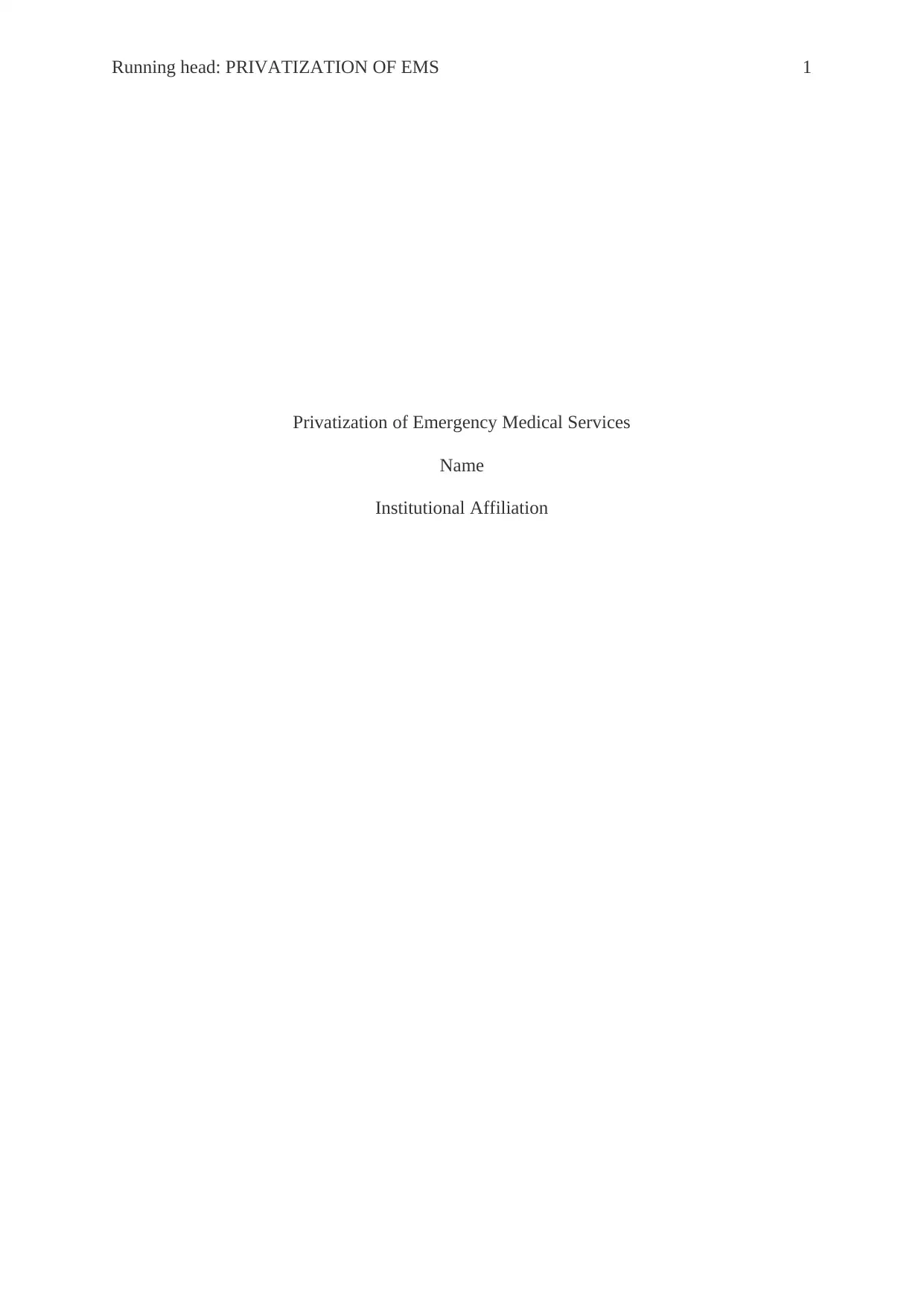
Running head: PRIVATIZATION OF EMS 1
Privatization of Emergency Medical Services
Name
Institutional Affiliation
Privatization of Emergency Medical Services
Name
Institutional Affiliation
Paraphrase This Document
Need a fresh take? Get an instant paraphrase of this document with our AI Paraphraser
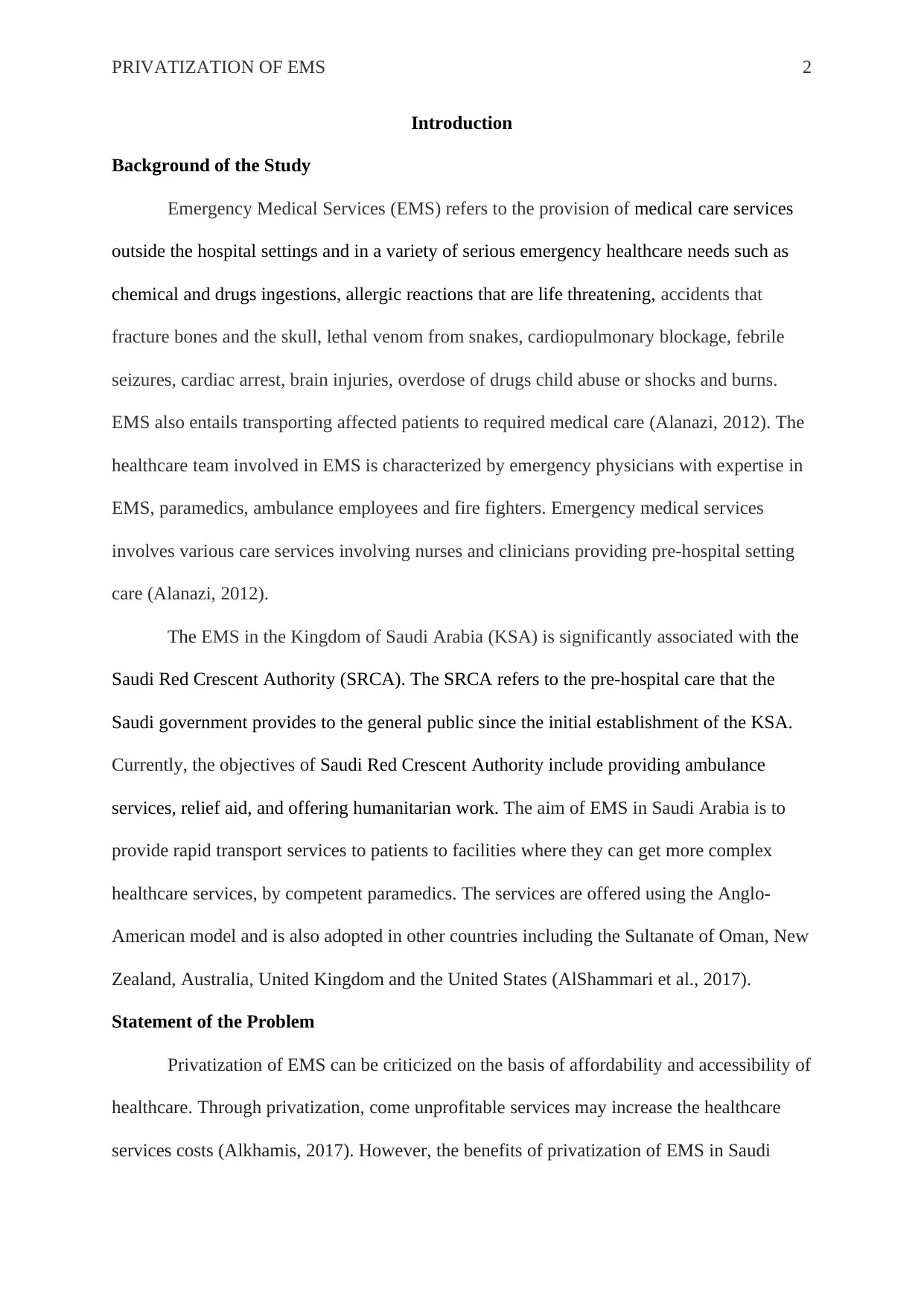
PRIVATIZATION OF EMS 2
Introduction
Background of the Study
Emergency Medical Services (EMS) refers to the provision of medical care services
outside the hospital settings and in a variety of serious emergency healthcare needs such as
chemical and drugs ingestions, allergic reactions that are life threatening, accidents that
fracture bones and the skull, lethal venom from snakes, cardiopulmonary blockage, febrile
seizures, cardiac arrest, brain injuries, overdose of drugs child abuse or shocks and burns.
EMS also entails transporting affected patients to required medical care (Alanazi, 2012). The
healthcare team involved in EMS is characterized by emergency physicians with expertise in
EMS, paramedics, ambulance employees and fire fighters. Emergency medical services
involves various care services involving nurses and clinicians providing pre-hospital setting
care (Alanazi, 2012).
The EMS in the Kingdom of Saudi Arabia (KSA) is significantly associated with the
Saudi Red Crescent Authority (SRCA). The SRCA refers to the pre-hospital care that the
Saudi government provides to the general public since the initial establishment of the KSA.
Currently, the objectives of Saudi Red Crescent Authority include providing ambulance
services, relief aid, and offering humanitarian work. The aim of EMS in Saudi Arabia is to
provide rapid transport services to patients to facilities where they can get more complex
healthcare services, by competent paramedics. The services are offered using the Anglo-
American model and is also adopted in other countries including the Sultanate of Oman, New
Zealand, Australia, United Kingdom and the United States (AlShammari et al., 2017).
Statement of the Problem
Privatization of EMS can be criticized on the basis of affordability and accessibility of
healthcare. Through privatization, come unprofitable services may increase the healthcare
services costs (Alkhamis, 2017). However, the benefits of privatization of EMS in Saudi
Introduction
Background of the Study
Emergency Medical Services (EMS) refers to the provision of medical care services
outside the hospital settings and in a variety of serious emergency healthcare needs such as
chemical and drugs ingestions, allergic reactions that are life threatening, accidents that
fracture bones and the skull, lethal venom from snakes, cardiopulmonary blockage, febrile
seizures, cardiac arrest, brain injuries, overdose of drugs child abuse or shocks and burns.
EMS also entails transporting affected patients to required medical care (Alanazi, 2012). The
healthcare team involved in EMS is characterized by emergency physicians with expertise in
EMS, paramedics, ambulance employees and fire fighters. Emergency medical services
involves various care services involving nurses and clinicians providing pre-hospital setting
care (Alanazi, 2012).
The EMS in the Kingdom of Saudi Arabia (KSA) is significantly associated with the
Saudi Red Crescent Authority (SRCA). The SRCA refers to the pre-hospital care that the
Saudi government provides to the general public since the initial establishment of the KSA.
Currently, the objectives of Saudi Red Crescent Authority include providing ambulance
services, relief aid, and offering humanitarian work. The aim of EMS in Saudi Arabia is to
provide rapid transport services to patients to facilities where they can get more complex
healthcare services, by competent paramedics. The services are offered using the Anglo-
American model and is also adopted in other countries including the Sultanate of Oman, New
Zealand, Australia, United Kingdom and the United States (AlShammari et al., 2017).
Statement of the Problem
Privatization of EMS can be criticized on the basis of affordability and accessibility of
healthcare. Through privatization, come unprofitable services may increase the healthcare
services costs (Alkhamis, 2017). However, the benefits of privatization of EMS in Saudi
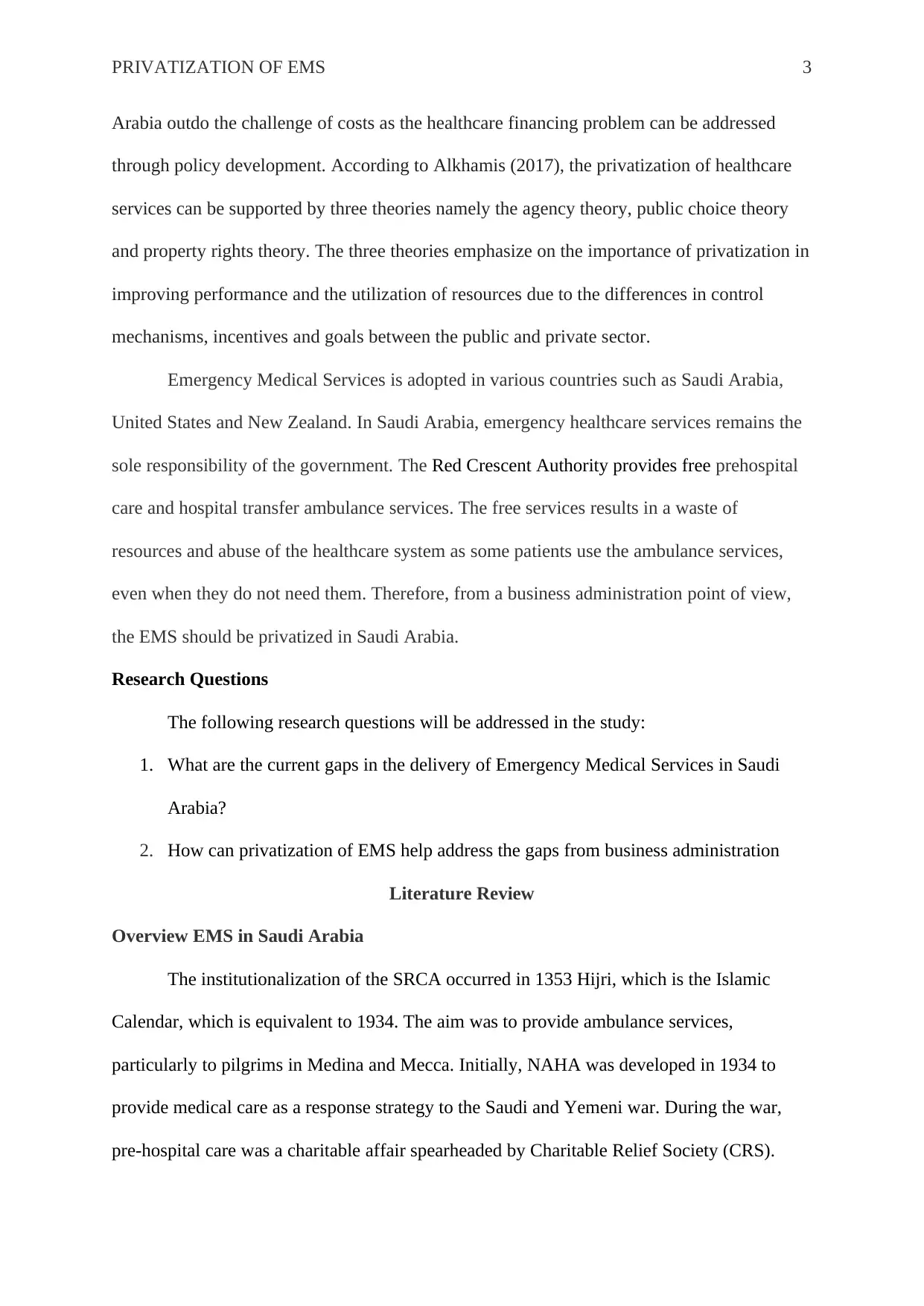
PRIVATIZATION OF EMS 3
Arabia outdo the challenge of costs as the healthcare financing problem can be addressed
through policy development. According to Alkhamis (2017), the privatization of healthcare
services can be supported by three theories namely the agency theory, public choice theory
and property rights theory. The three theories emphasize on the importance of privatization in
improving performance and the utilization of resources due to the differences in control
mechanisms, incentives and goals between the public and private sector.
Emergency Medical Services is adopted in various countries such as Saudi Arabia,
United States and New Zealand. In Saudi Arabia, emergency healthcare services remains the
sole responsibility of the government. The Red Crescent Authority provides free prehospital
care and hospital transfer ambulance services. The free services results in a waste of
resources and abuse of the healthcare system as some patients use the ambulance services,
even when they do not need them. Therefore, from a business administration point of view,
the EMS should be privatized in Saudi Arabia.
Research Questions
The following research questions will be addressed in the study:
1. What are the current gaps in the delivery of Emergency Medical Services in Saudi
Arabia?
2. How can privatization of EMS help address the gaps from business administration
Literature Review
Overview EMS in Saudi Arabia
The institutionalization of the SRCA occurred in 1353 Hijri, which is the Islamic
Calendar, which is equivalent to 1934. The aim was to provide ambulance services,
particularly to pilgrims in Medina and Mecca. Initially, NAHA was developed in 1934 to
provide medical care as a response strategy to the Saudi and Yemeni war. During the war,
pre-hospital care was a charitable affair spearheaded by Charitable Relief Society (CRS).
Arabia outdo the challenge of costs as the healthcare financing problem can be addressed
through policy development. According to Alkhamis (2017), the privatization of healthcare
services can be supported by three theories namely the agency theory, public choice theory
and property rights theory. The three theories emphasize on the importance of privatization in
improving performance and the utilization of resources due to the differences in control
mechanisms, incentives and goals between the public and private sector.
Emergency Medical Services is adopted in various countries such as Saudi Arabia,
United States and New Zealand. In Saudi Arabia, emergency healthcare services remains the
sole responsibility of the government. The Red Crescent Authority provides free prehospital
care and hospital transfer ambulance services. The free services results in a waste of
resources and abuse of the healthcare system as some patients use the ambulance services,
even when they do not need them. Therefore, from a business administration point of view,
the EMS should be privatized in Saudi Arabia.
Research Questions
The following research questions will be addressed in the study:
1. What are the current gaps in the delivery of Emergency Medical Services in Saudi
Arabia?
2. How can privatization of EMS help address the gaps from business administration
Literature Review
Overview EMS in Saudi Arabia
The institutionalization of the SRCA occurred in 1353 Hijri, which is the Islamic
Calendar, which is equivalent to 1934. The aim was to provide ambulance services,
particularly to pilgrims in Medina and Mecca. Initially, NAHA was developed in 1934 to
provide medical care as a response strategy to the Saudi and Yemeni war. During the war,
pre-hospital care was a charitable affair spearheaded by Charitable Relief Society (CRS).
⊘ This is a preview!⊘
Do you want full access?
Subscribe today to unlock all pages.

Trusted by 1+ million students worldwide
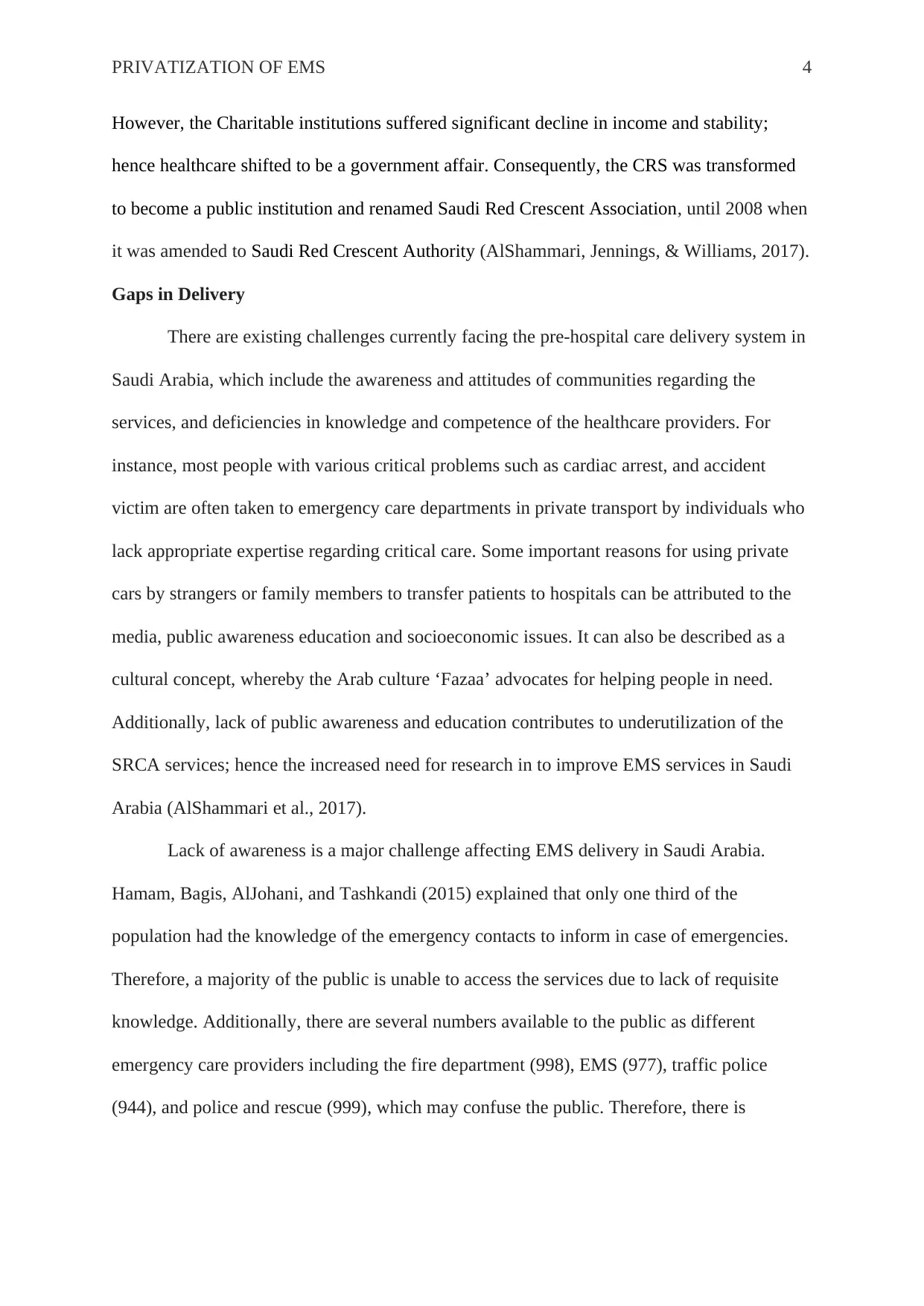
PRIVATIZATION OF EMS 4
However, the Charitable institutions suffered significant decline in income and stability;
hence healthcare shifted to be a government affair. Consequently, the CRS was transformed
to become a public institution and renamed Saudi Red Crescent Association, until 2008 when
it was amended to Saudi Red Crescent Authority (AlShammari, Jennings, & Williams, 2017).
Gaps in Delivery
There are existing challenges currently facing the pre-hospital care delivery system in
Saudi Arabia, which include the awareness and attitudes of communities regarding the
services, and deficiencies in knowledge and competence of the healthcare providers. For
instance, most people with various critical problems such as cardiac arrest, and accident
victim are often taken to emergency care departments in private transport by individuals who
lack appropriate expertise regarding critical care. Some important reasons for using private
cars by strangers or family members to transfer patients to hospitals can be attributed to the
media, public awareness education and socioeconomic issues. It can also be described as a
cultural concept, whereby the Arab culture ‘Fazaa’ advocates for helping people in need.
Additionally, lack of public awareness and education contributes to underutilization of the
SRCA services; hence the increased need for research in to improve EMS services in Saudi
Arabia (AlShammari et al., 2017).
Lack of awareness is a major challenge affecting EMS delivery in Saudi Arabia.
Hamam, Bagis, AlJohani, and Tashkandi (2015) explained that only one third of the
population had the knowledge of the emergency contacts to inform in case of emergencies.
Therefore, a majority of the public is unable to access the services due to lack of requisite
knowledge. Additionally, there are several numbers available to the public as different
emergency care providers including the fire department (998), EMS (977), traffic police
(944), and police and rescue (999), which may confuse the public. Therefore, there is
However, the Charitable institutions suffered significant decline in income and stability;
hence healthcare shifted to be a government affair. Consequently, the CRS was transformed
to become a public institution and renamed Saudi Red Crescent Association, until 2008 when
it was amended to Saudi Red Crescent Authority (AlShammari, Jennings, & Williams, 2017).
Gaps in Delivery
There are existing challenges currently facing the pre-hospital care delivery system in
Saudi Arabia, which include the awareness and attitudes of communities regarding the
services, and deficiencies in knowledge and competence of the healthcare providers. For
instance, most people with various critical problems such as cardiac arrest, and accident
victim are often taken to emergency care departments in private transport by individuals who
lack appropriate expertise regarding critical care. Some important reasons for using private
cars by strangers or family members to transfer patients to hospitals can be attributed to the
media, public awareness education and socioeconomic issues. It can also be described as a
cultural concept, whereby the Arab culture ‘Fazaa’ advocates for helping people in need.
Additionally, lack of public awareness and education contributes to underutilization of the
SRCA services; hence the increased need for research in to improve EMS services in Saudi
Arabia (AlShammari et al., 2017).
Lack of awareness is a major challenge affecting EMS delivery in Saudi Arabia.
Hamam, Bagis, AlJohani, and Tashkandi (2015) explained that only one third of the
population had the knowledge of the emergency contacts to inform in case of emergencies.
Therefore, a majority of the public is unable to access the services due to lack of requisite
knowledge. Additionally, there are several numbers available to the public as different
emergency care providers including the fire department (998), EMS (977), traffic police
(944), and police and rescue (999), which may confuse the public. Therefore, there is
Paraphrase This Document
Need a fresh take? Get an instant paraphrase of this document with our AI Paraphraser
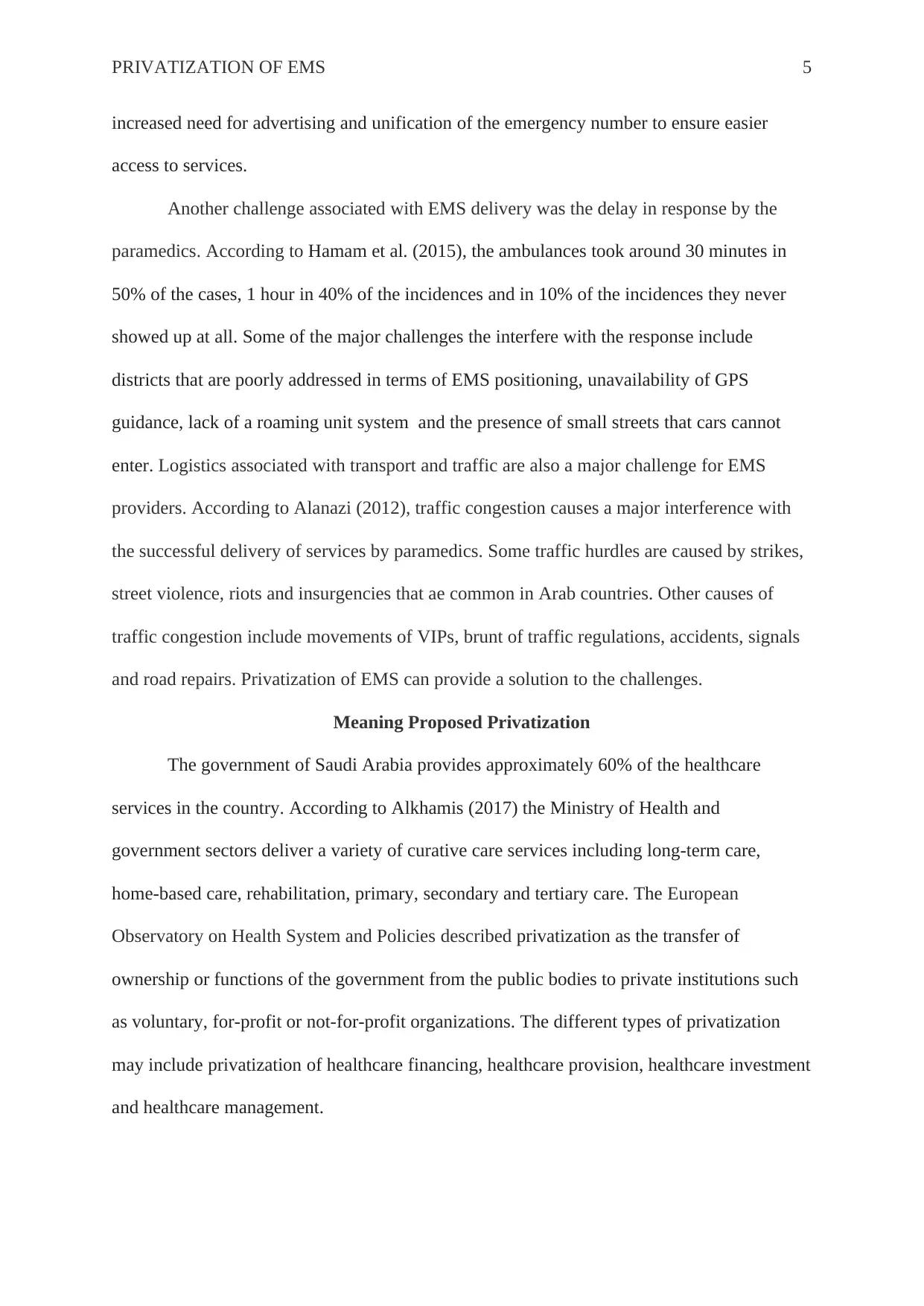
PRIVATIZATION OF EMS 5
increased need for advertising and unification of the emergency number to ensure easier
access to services.
Another challenge associated with EMS delivery was the delay in response by the
paramedics. According to Hamam et al. (2015), the ambulances took around 30 minutes in
50% of the cases, 1 hour in 40% of the incidences and in 10% of the incidences they never
showed up at all. Some of the major challenges the interfere with the response include
districts that are poorly addressed in terms of EMS positioning, unavailability of GPS
guidance, lack of a roaming unit system and the presence of small streets that cars cannot
enter. Logistics associated with transport and traffic are also a major challenge for EMS
providers. According to Alanazi (2012), traffic congestion causes a major interference with
the successful delivery of services by paramedics. Some traffic hurdles are caused by strikes,
street violence, riots and insurgencies that ae common in Arab countries. Other causes of
traffic congestion include movements of VIPs, brunt of traffic regulations, accidents, signals
and road repairs. Privatization of EMS can provide a solution to the challenges.
Meaning Proposed Privatization
The government of Saudi Arabia provides approximately 60% of the healthcare
services in the country. According to Alkhamis (2017) the Ministry of Health and
government sectors deliver a variety of curative care services including long-term care,
home-based care, rehabilitation, primary, secondary and tertiary care. The European
Observatory on Health System and Policies described privatization as the transfer of
ownership or functions of the government from the public bodies to private institutions such
as voluntary, for-profit or not-for-profit organizations. The different types of privatization
may include privatization of healthcare financing, healthcare provision, healthcare investment
and healthcare management.
increased need for advertising and unification of the emergency number to ensure easier
access to services.
Another challenge associated with EMS delivery was the delay in response by the
paramedics. According to Hamam et al. (2015), the ambulances took around 30 minutes in
50% of the cases, 1 hour in 40% of the incidences and in 10% of the incidences they never
showed up at all. Some of the major challenges the interfere with the response include
districts that are poorly addressed in terms of EMS positioning, unavailability of GPS
guidance, lack of a roaming unit system and the presence of small streets that cars cannot
enter. Logistics associated with transport and traffic are also a major challenge for EMS
providers. According to Alanazi (2012), traffic congestion causes a major interference with
the successful delivery of services by paramedics. Some traffic hurdles are caused by strikes,
street violence, riots and insurgencies that ae common in Arab countries. Other causes of
traffic congestion include movements of VIPs, brunt of traffic regulations, accidents, signals
and road repairs. Privatization of EMS can provide a solution to the challenges.
Meaning Proposed Privatization
The government of Saudi Arabia provides approximately 60% of the healthcare
services in the country. According to Alkhamis (2017) the Ministry of Health and
government sectors deliver a variety of curative care services including long-term care,
home-based care, rehabilitation, primary, secondary and tertiary care. The European
Observatory on Health System and Policies described privatization as the transfer of
ownership or functions of the government from the public bodies to private institutions such
as voluntary, for-profit or not-for-profit organizations. The different types of privatization
may include privatization of healthcare financing, healthcare provision, healthcare investment
and healthcare management.
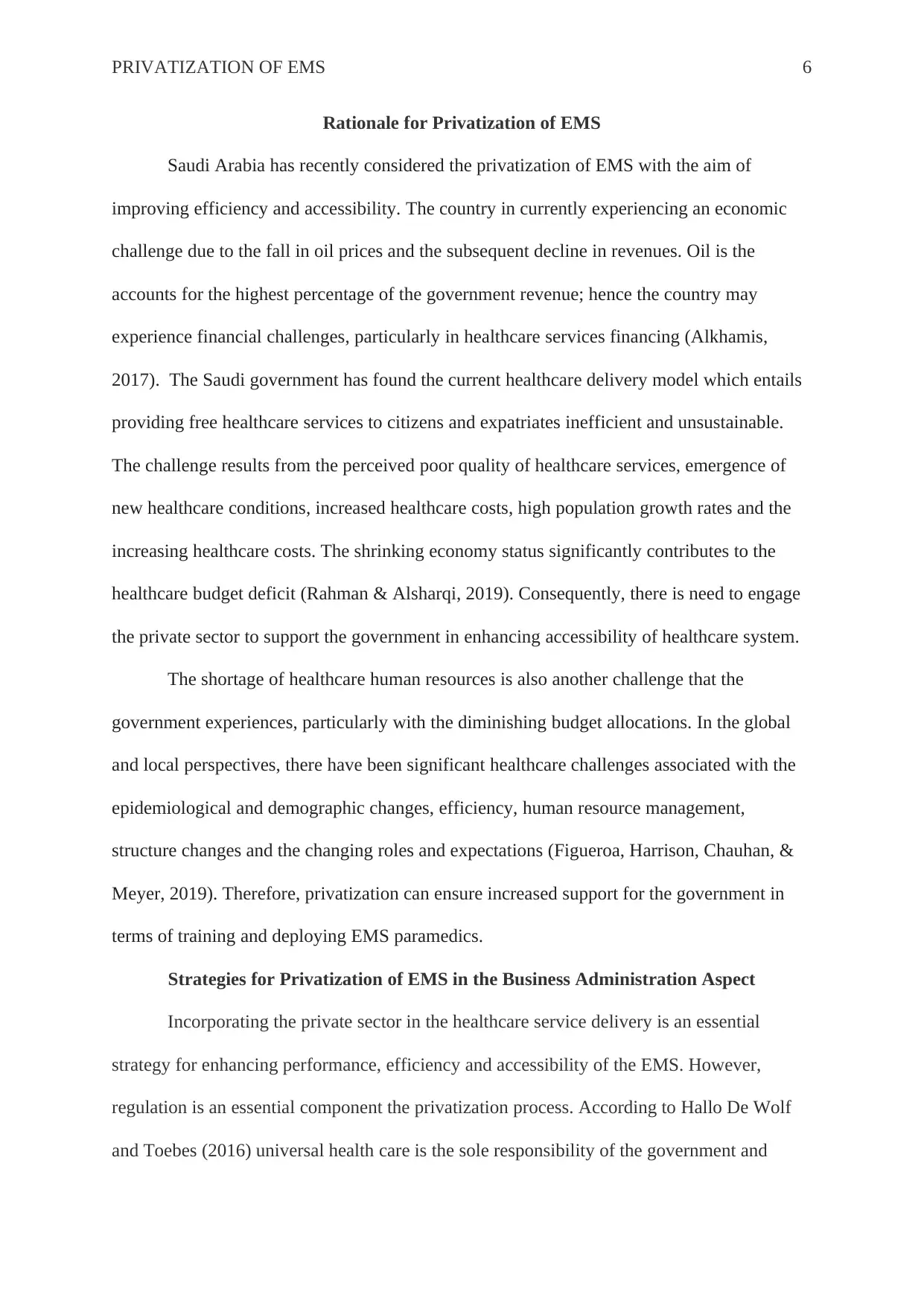
PRIVATIZATION OF EMS 6
Rationale for Privatization of EMS
Saudi Arabia has recently considered the privatization of EMS with the aim of
improving efficiency and accessibility. The country in currently experiencing an economic
challenge due to the fall in oil prices and the subsequent decline in revenues. Oil is the
accounts for the highest percentage of the government revenue; hence the country may
experience financial challenges, particularly in healthcare services financing (Alkhamis,
2017). The Saudi government has found the current healthcare delivery model which entails
providing free healthcare services to citizens and expatriates inefficient and unsustainable.
The challenge results from the perceived poor quality of healthcare services, emergence of
new healthcare conditions, increased healthcare costs, high population growth rates and the
increasing healthcare costs. The shrinking economy status significantly contributes to the
healthcare budget deficit (Rahman & Alsharqi, 2019). Consequently, there is need to engage
the private sector to support the government in enhancing accessibility of healthcare system.
The shortage of healthcare human resources is also another challenge that the
government experiences, particularly with the diminishing budget allocations. In the global
and local perspectives, there have been significant healthcare challenges associated with the
epidemiological and demographic changes, efficiency, human resource management,
structure changes and the changing roles and expectations (Figueroa, Harrison, Chauhan, &
Meyer, 2019). Therefore, privatization can ensure increased support for the government in
terms of training and deploying EMS paramedics.
Strategies for Privatization of EMS in the Business Administration Aspect
Incorporating the private sector in the healthcare service delivery is an essential
strategy for enhancing performance, efficiency and accessibility of the EMS. However,
regulation is an essential component the privatization process. According to Hallo De Wolf
and Toebes (2016) universal health care is the sole responsibility of the government and
Rationale for Privatization of EMS
Saudi Arabia has recently considered the privatization of EMS with the aim of
improving efficiency and accessibility. The country in currently experiencing an economic
challenge due to the fall in oil prices and the subsequent decline in revenues. Oil is the
accounts for the highest percentage of the government revenue; hence the country may
experience financial challenges, particularly in healthcare services financing (Alkhamis,
2017). The Saudi government has found the current healthcare delivery model which entails
providing free healthcare services to citizens and expatriates inefficient and unsustainable.
The challenge results from the perceived poor quality of healthcare services, emergence of
new healthcare conditions, increased healthcare costs, high population growth rates and the
increasing healthcare costs. The shrinking economy status significantly contributes to the
healthcare budget deficit (Rahman & Alsharqi, 2019). Consequently, there is need to engage
the private sector to support the government in enhancing accessibility of healthcare system.
The shortage of healthcare human resources is also another challenge that the
government experiences, particularly with the diminishing budget allocations. In the global
and local perspectives, there have been significant healthcare challenges associated with the
epidemiological and demographic changes, efficiency, human resource management,
structure changes and the changing roles and expectations (Figueroa, Harrison, Chauhan, &
Meyer, 2019). Therefore, privatization can ensure increased support for the government in
terms of training and deploying EMS paramedics.
Strategies for Privatization of EMS in the Business Administration Aspect
Incorporating the private sector in the healthcare service delivery is an essential
strategy for enhancing performance, efficiency and accessibility of the EMS. However,
regulation is an essential component the privatization process. According to Hallo De Wolf
and Toebes (2016) universal health care is the sole responsibility of the government and
⊘ This is a preview!⊘
Do you want full access?
Subscribe today to unlock all pages.

Trusted by 1+ million students worldwide
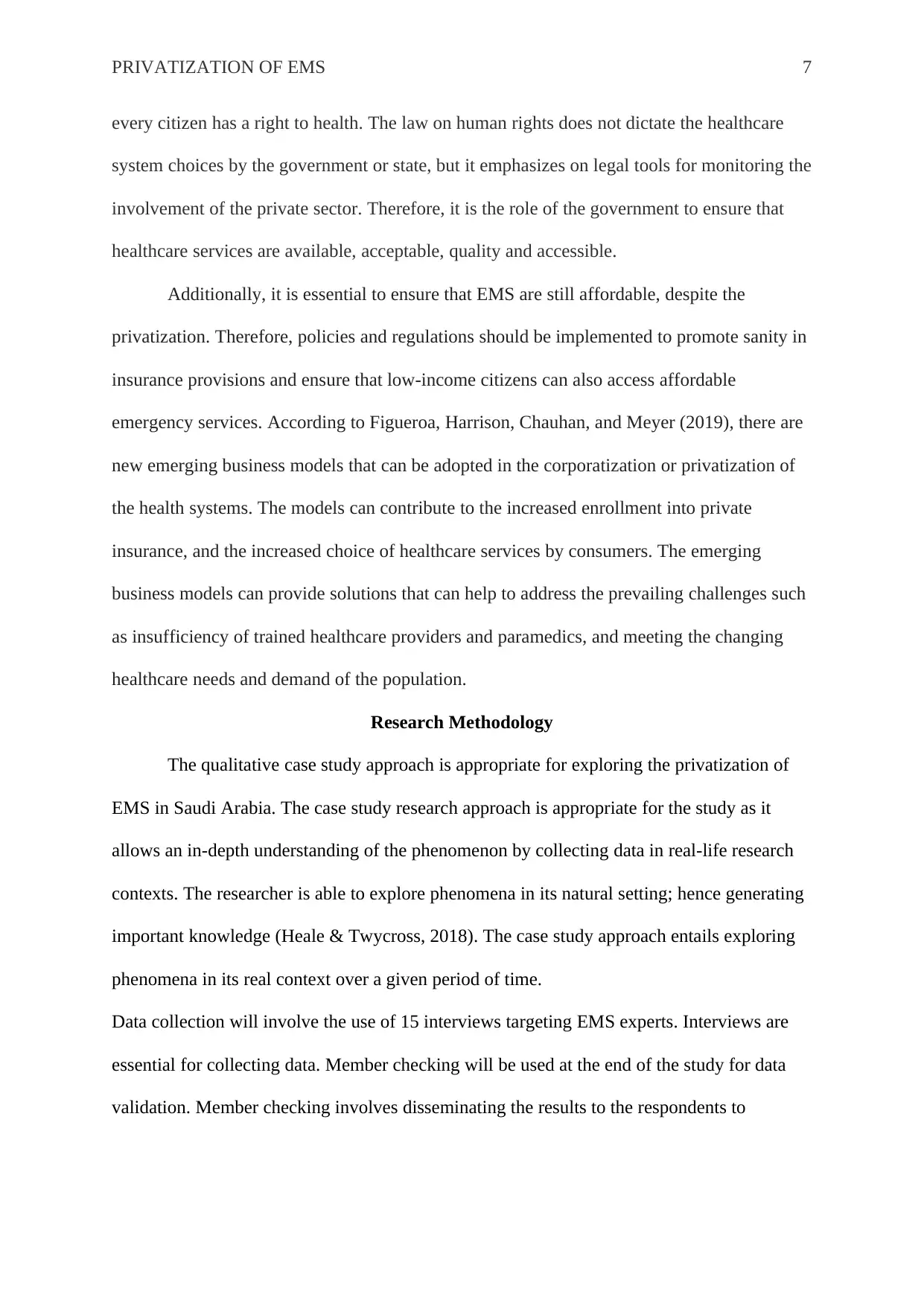
PRIVATIZATION OF EMS 7
every citizen has a right to health. The law on human rights does not dictate the healthcare
system choices by the government or state, but it emphasizes on legal tools for monitoring the
involvement of the private sector. Therefore, it is the role of the government to ensure that
healthcare services are available, acceptable, quality and accessible.
Additionally, it is essential to ensure that EMS are still affordable, despite the
privatization. Therefore, policies and regulations should be implemented to promote sanity in
insurance provisions and ensure that low-income citizens can also access affordable
emergency services. According to Figueroa, Harrison, Chauhan, and Meyer (2019), there are
new emerging business models that can be adopted in the corporatization or privatization of
the health systems. The models can contribute to the increased enrollment into private
insurance, and the increased choice of healthcare services by consumers. The emerging
business models can provide solutions that can help to address the prevailing challenges such
as insufficiency of trained healthcare providers and paramedics, and meeting the changing
healthcare needs and demand of the population.
Research Methodology
The qualitative case study approach is appropriate for exploring the privatization of
EMS in Saudi Arabia. The case study research approach is appropriate for the study as it
allows an in-depth understanding of the phenomenon by collecting data in real-life research
contexts. The researcher is able to explore phenomena in its natural setting; hence generating
important knowledge (Heale & Twycross, 2018). The case study approach entails exploring
phenomena in its real context over a given period of time.
Data collection will involve the use of 15 interviews targeting EMS experts. Interviews are
essential for collecting data. Member checking will be used at the end of the study for data
validation. Member checking involves disseminating the results to the respondents to
every citizen has a right to health. The law on human rights does not dictate the healthcare
system choices by the government or state, but it emphasizes on legal tools for monitoring the
involvement of the private sector. Therefore, it is the role of the government to ensure that
healthcare services are available, acceptable, quality and accessible.
Additionally, it is essential to ensure that EMS are still affordable, despite the
privatization. Therefore, policies and regulations should be implemented to promote sanity in
insurance provisions and ensure that low-income citizens can also access affordable
emergency services. According to Figueroa, Harrison, Chauhan, and Meyer (2019), there are
new emerging business models that can be adopted in the corporatization or privatization of
the health systems. The models can contribute to the increased enrollment into private
insurance, and the increased choice of healthcare services by consumers. The emerging
business models can provide solutions that can help to address the prevailing challenges such
as insufficiency of trained healthcare providers and paramedics, and meeting the changing
healthcare needs and demand of the population.
Research Methodology
The qualitative case study approach is appropriate for exploring the privatization of
EMS in Saudi Arabia. The case study research approach is appropriate for the study as it
allows an in-depth understanding of the phenomenon by collecting data in real-life research
contexts. The researcher is able to explore phenomena in its natural setting; hence generating
important knowledge (Heale & Twycross, 2018). The case study approach entails exploring
phenomena in its real context over a given period of time.
Data collection will involve the use of 15 interviews targeting EMS experts. Interviews are
essential for collecting data. Member checking will be used at the end of the study for data
validation. Member checking involves disseminating the results to the respondents to
Paraphrase This Document
Need a fresh take? Get an instant paraphrase of this document with our AI Paraphraser

PRIVATIZATION OF EMS 8
ascertain whether they resonate with the data they provided (Birt, Scott, Cavers, Campbell,
& Walter, 2016). Thematic analysis will be used to perform the data analysis.
ascertain whether they resonate with the data they provided (Birt, Scott, Cavers, Campbell,
& Walter, 2016). Thematic analysis will be used to perform the data analysis.
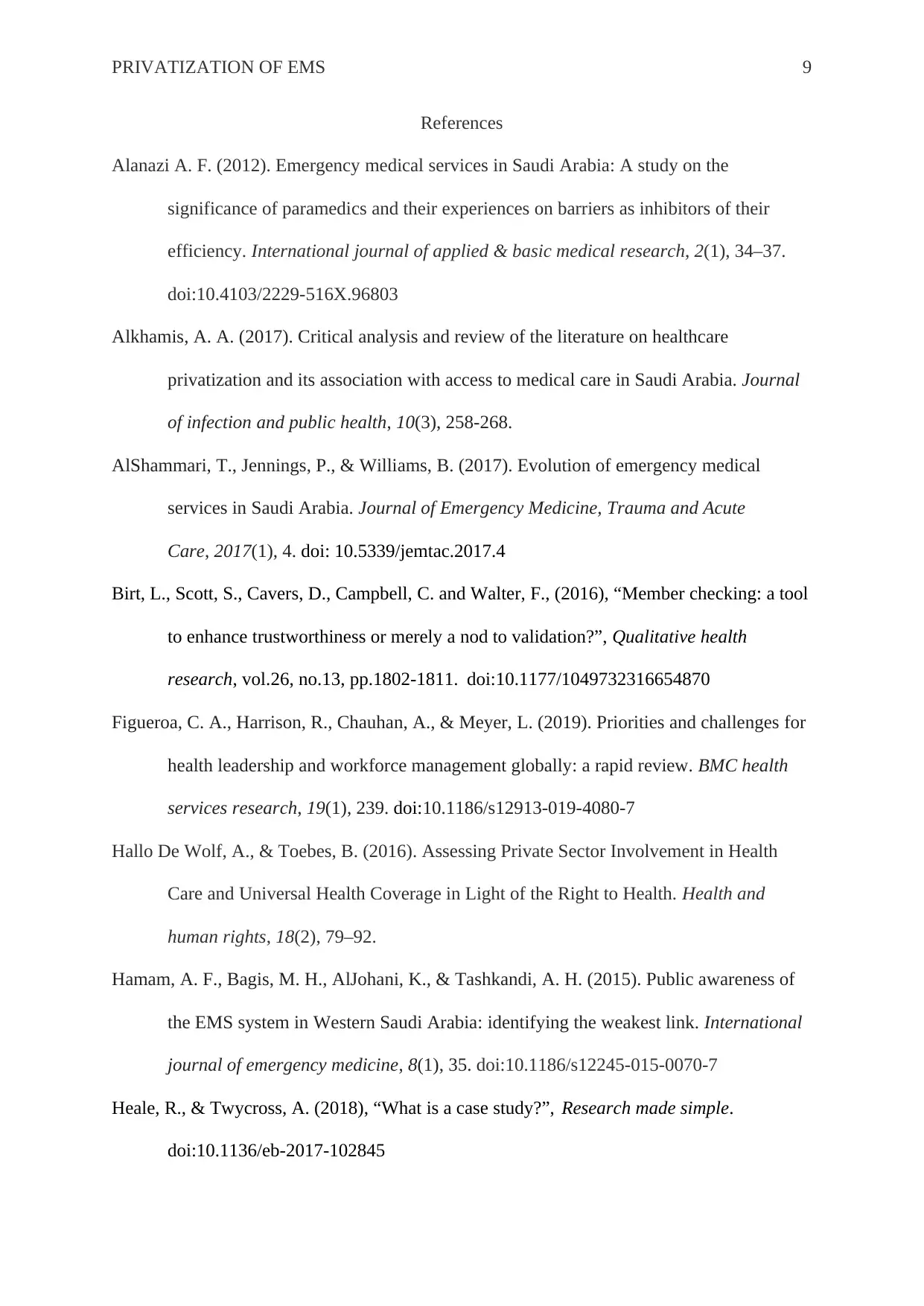
PRIVATIZATION OF EMS 9
References
Alanazi A. F. (2012). Emergency medical services in Saudi Arabia: A study on the
significance of paramedics and their experiences on barriers as inhibitors of their
efficiency. International journal of applied & basic medical research, 2(1), 34–37.
doi:10.4103/2229-516X.96803
Alkhamis, A. A. (2017). Critical analysis and review of the literature on healthcare
privatization and its association with access to medical care in Saudi Arabia. Journal
of infection and public health, 10(3), 258-268.
AlShammari, T., Jennings, P., & Williams, B. (2017). Evolution of emergency medical
services in Saudi Arabia. Journal of Emergency Medicine, Trauma and Acute
Care, 2017(1), 4. doi: 10.5339/jemtac.2017.4
Birt, L., Scott, S., Cavers, D., Campbell, C. and Walter, F., (2016), “Member checking: a tool
to enhance trustworthiness or merely a nod to validation?”, Qualitative health
research, vol.26, no.13, pp.1802-1811. doi:10.1177/1049732316654870
Figueroa, C. A., Harrison, R., Chauhan, A., & Meyer, L. (2019). Priorities and challenges for
health leadership and workforce management globally: a rapid review. BMC health
services research, 19(1), 239. doi:10.1186/s12913-019-4080-7
Hallo De Wolf, A., & Toebes, B. (2016). Assessing Private Sector Involvement in Health
Care and Universal Health Coverage in Light of the Right to Health. Health and
human rights, 18(2), 79–92.
Hamam, A. F., Bagis, M. H., AlJohani, K., & Tashkandi, A. H. (2015). Public awareness of
the EMS system in Western Saudi Arabia: identifying the weakest link. International
journal of emergency medicine, 8(1), 35. doi:10.1186/s12245-015-0070-7
Heale, R., & Twycross, A. (2018), “What is a case study?”, Research made simple.
doi:10.1136/eb-2017-102845
References
Alanazi A. F. (2012). Emergency medical services in Saudi Arabia: A study on the
significance of paramedics and their experiences on barriers as inhibitors of their
efficiency. International journal of applied & basic medical research, 2(1), 34–37.
doi:10.4103/2229-516X.96803
Alkhamis, A. A. (2017). Critical analysis and review of the literature on healthcare
privatization and its association with access to medical care in Saudi Arabia. Journal
of infection and public health, 10(3), 258-268.
AlShammari, T., Jennings, P., & Williams, B. (2017). Evolution of emergency medical
services in Saudi Arabia. Journal of Emergency Medicine, Trauma and Acute
Care, 2017(1), 4. doi: 10.5339/jemtac.2017.4
Birt, L., Scott, S., Cavers, D., Campbell, C. and Walter, F., (2016), “Member checking: a tool
to enhance trustworthiness or merely a nod to validation?”, Qualitative health
research, vol.26, no.13, pp.1802-1811. doi:10.1177/1049732316654870
Figueroa, C. A., Harrison, R., Chauhan, A., & Meyer, L. (2019). Priorities and challenges for
health leadership and workforce management globally: a rapid review. BMC health
services research, 19(1), 239. doi:10.1186/s12913-019-4080-7
Hallo De Wolf, A., & Toebes, B. (2016). Assessing Private Sector Involvement in Health
Care and Universal Health Coverage in Light of the Right to Health. Health and
human rights, 18(2), 79–92.
Hamam, A. F., Bagis, M. H., AlJohani, K., & Tashkandi, A. H. (2015). Public awareness of
the EMS system in Western Saudi Arabia: identifying the weakest link. International
journal of emergency medicine, 8(1), 35. doi:10.1186/s12245-015-0070-7
Heale, R., & Twycross, A. (2018), “What is a case study?”, Research made simple.
doi:10.1136/eb-2017-102845
⊘ This is a preview!⊘
Do you want full access?
Subscribe today to unlock all pages.

Trusted by 1+ million students worldwide
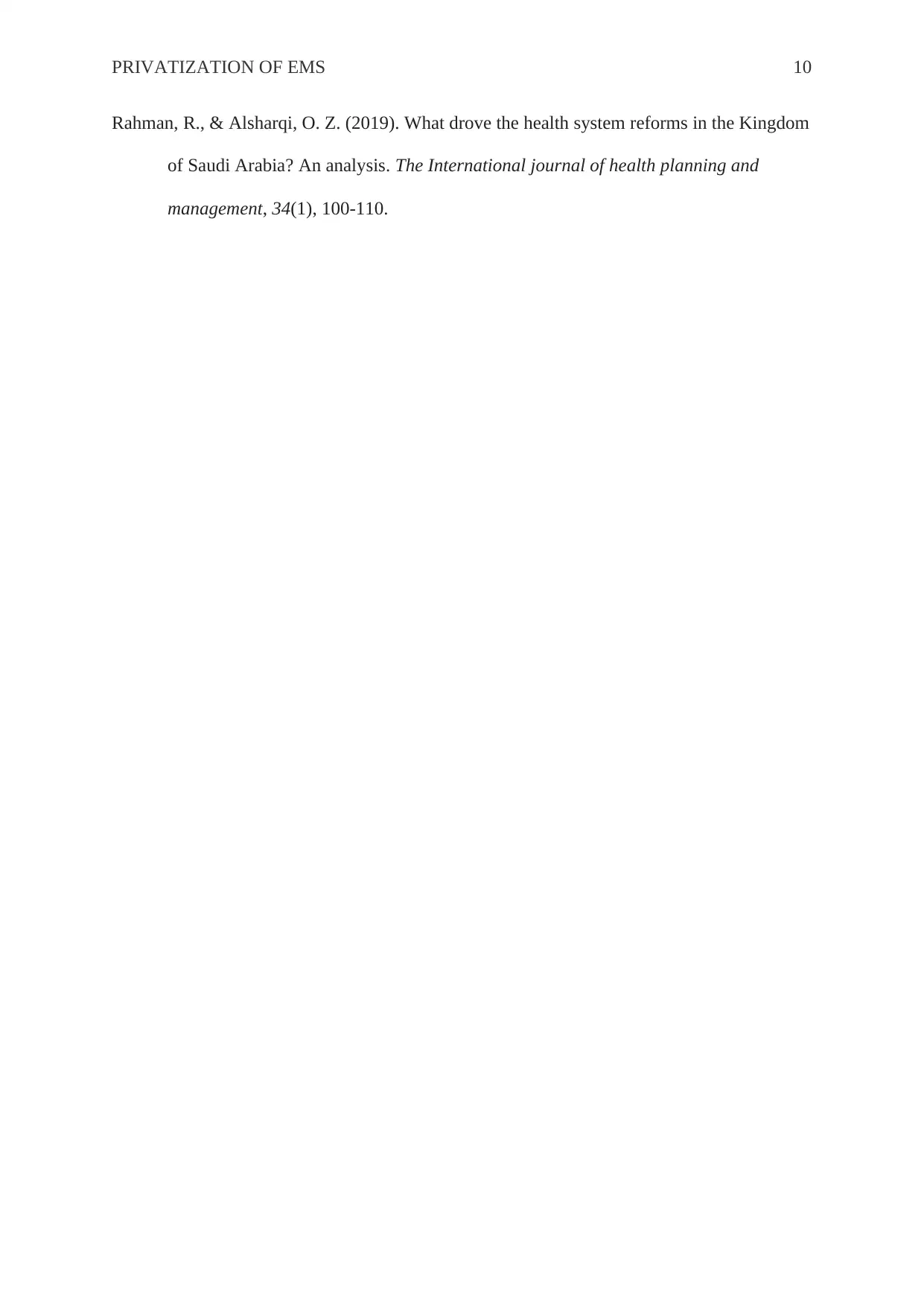
PRIVATIZATION OF EMS 10
Rahman, R., & Alsharqi, O. Z. (2019). What drove the health system reforms in the Kingdom
of Saudi Arabia? An analysis. The International journal of health planning and
management, 34(1), 100-110.
Rahman, R., & Alsharqi, O. Z. (2019). What drove the health system reforms in the Kingdom
of Saudi Arabia? An analysis. The International journal of health planning and
management, 34(1), 100-110.
1 out of 10
Your All-in-One AI-Powered Toolkit for Academic Success.
+13062052269
info@desklib.com
Available 24*7 on WhatsApp / Email
![[object Object]](/_next/static/media/star-bottom.7253800d.svg)
Unlock your academic potential
Copyright © 2020–2025 A2Z Services. All Rights Reserved. Developed and managed by ZUCOL.


